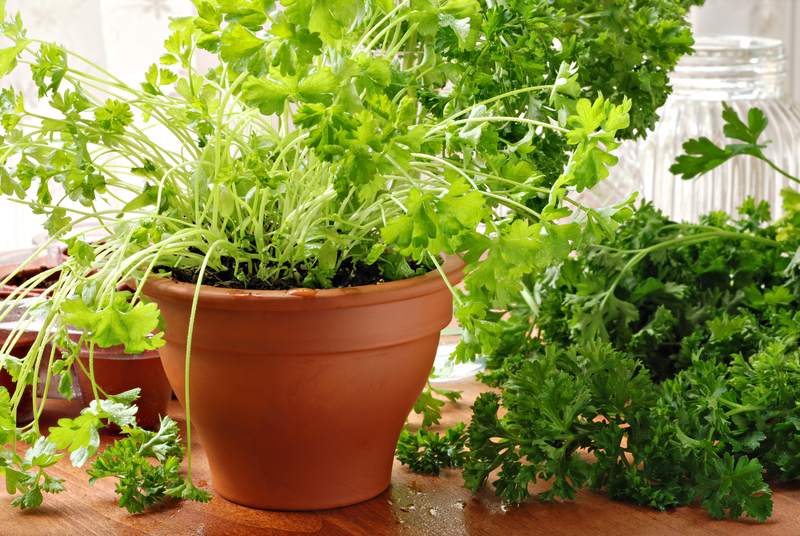Find Inner Peace with These Zen Garden Elements
Posted on 12/09/2025
Find Inner Peace with These Zen Garden Elements
Looking for a way to find inner peace in your daily life? One approach that has been practiced for centuries is the creation and appreciation of Zen gardens. These tranquil spaces, also known as Japanese rock gardens or karesansui, are designed to inspire meditation, relaxation, and mindfulness. By incorporating essential Zen garden elements into your outdoor or indoor spaces, you can bring harmony, stillness, and a sense of flow into your environment. In this comprehensive guide, we'll explore the core components of Zen-inspired gardens, their symbolism, and practical ways to create your own serene sanctuary.
What Is a Zen Garden? Unveiling the Philosophy and Purpose
Before designing a Zen garden to cultivate inner peace, it's important to understand what distinguishes these gardens from other styles. Originating in Japan during the late 13th century, Zen gardens are minimalist landscapes meant to evoke the beauty of nature while providing a canvas for meditation and mindfulness. Their primary purpose is not just aesthetic pleasure, but also spiritual reflection, focusing the mind and helping one achieve tranquility even amidst life's chaos.
- Simplicity: Zen gardens use a minimalist approach, employing few but carefully chosen elements.
- Symbolism: Every feature in a Zen garden has a deeper meaning, representing natural elements like mountains, islands, rivers, or the sea.
- Mindfulness: The process of arranging, raking, and tending to the garden becomes a meditative practice.
By understanding these guiding principles, you'll soon realize that a Zen garden is more than a landscape--it's a living meditation tool, elevating your peace of mind.

Essential Zen Garden Elements for Tranquility
Ready to design a sanctuary where you can find inner calm? The following are the most iconic and meaningful Zen garden features you can incorporate to evoke calm and focus in any setting.
1. Rocks: The Backbone of Zen Serenity
Rocks and stones are at the heart of Zen garden landscaping. They symbolize nature's strength and timelessness--often representing islands, mountains, or living beings. The careful placement of rocks is an art form known as Ishi wo taten koto, emphasizing balance, contrast, and asymmetry.
- Vertical stones: Often symbolize mountains or trees.
- Flat stones: Represent water surfaces or stepping stones.
- Grouped stones: Form symbolic arrangements such as "triad" groupings to mirror famous natural landscapes.
When planning your garden, use natural, uncut stones of various sizes, textures, and shapes. Avoid symmetrical placement for a more authentic, peaceful Zen garden aesthetic.
2. Gravel and Sand: The Flow of Mindfulness
Gravel or sand is typically used to represent water in Zen gardens. It may seem paradoxical to use these dry elements for water, but the act of raking gravel into flowing patterns captures the movement of rivers or waves. This practice fosters mindfulness, as each stroke calms and focuses the mind.
- Symbolism: Sand and gravel symbolize purity, openness, and the impermanence of existence.
- Raking patterns: Swirls can mimic ocean waves, while straight lines suggest a tranquil river.
- Maintenance: Raking acts as a daily meditative ritual, allowing you to express and refresh your inner state.
Choose light-colored, finely crushed gravel or sand for the most traditional effect. The raking process itself is as important as the final design--it's about finding peace in the present moment.
3. Water Features: Inviting Movement and Sound
While sand and gravel stand in for water, the addition of actual water features can increase the feeling of tranquility. Sounds from a simple bamboo water fountain (shishi-odoshi) or a calm pond gently soothe the senses, washing away stress and inviting reflection.
- Ponds: Symbolize the sea or a peaceful lake, often with koi fish adding color and interest.
- Streams: Represent the passage of time.
- Shishi-odoshi: Traditional bamboo devices that make a calming "clack" to scare away intrusive thoughts (and deer!).
If space is limited, even a small stone basin or tabletop fountain can foster inner tranquility and the meditative rhythm of flowing water.
4. Moss and Plants: Softening the Edges
While Zen gardens often emphasize rocks and clean lines, plants and moss play an understated yet vital role. Moss is especially valued in Japanese Zen gardens for its capacity to evoke age, wisdom, and permanence. Minimal plantings serve to highlight simplicity and seasonal change.
- Moss: Softens hard surfaces and creates a calming, ancient ambiance.
- Bamboo: Symbolizes strength, flexibility, and humility.
- Evergreens and shrubs: Offer year-round serenity and structure.
Choose shade-loving, slow-growing species and keep landscaping understated. Prune thoughtfully to maintain the uncluttered, peaceful look that defines Zen landscape design.
5. Lanterns: Emblems of Enlightenment
Stone lanterns or toro are classic features in Zen-inspired gardens. More than decoration, they traditionally illuminate pathways--symbolizing knowledge guiding one through darkness. Their presence can inspire meditation after sunset, adding peace and mystery to the garden.
- Kasuga-doro: Made of granite or other stone, featuring ornate roofs.
- Yukimi-doro: "Snow-viewing" lanterns with wide brims, set near ponds or streams.
Arrange your lanterns sparingly, highlighting key viewpoints or transitions in the garden. The soft glow at dusk creates a perfect space for quiet contemplation and finding inner calm.
6. Bridges: Symbols of Transition
Bridge elements in Zen gardens, whether simple wooden planks or graceful arched versions, carry deep meaning. They symbolize the passage from one world to another--the transition from the material to the spiritual, from turmoil to inner peace.
- Flat bridges: Suggest simplicity and straightforwardness.
- Arched bridges: Imbue the space with elegance and a sense of journey or passage.
Incorporate bridges over water or dry gravel "streams" to create focal points and remind yourself of life's ongoing path of growth.
7. Pathways and Stepping Stones: Guiding Meditation
Stepping stones and meandering paths encourage a slow, mindful journey through your Zen garden. They facilitate movement for both the body and the mind, helping break habitual ways of thinking and inviting a fresh perspective on life.
- Irregular layouts: Enhance mindfulness, as each step must be deliberate.
- Nesting stones: Lead to public areas or private spots for meditation.
Choose natural stone, wood, or gravel for maximum authenticity. Avoid straight lines, favoring curves and unpredictable arrangements to nurture curiosity and discovery.
Designing Your Own Zen Sanctuary: Step-by-Step Guide
Ready to cultivate a peaceful escape at home or in your workspace? Follow these practical steps to integrate Zen garden elements and foster a daily sense of inner calm:
- Choose Your Location: Indoors or outdoors, select a spot where you can spend time in peace and seclusion.
- Embrace Minimalism: Less is more. Focus on a few well-chosen elements over crowded arrangements.
- Start with a Base: Lay down sand or gravel to represent water. Frame with natural edging stones or low bamboo fencing.
- Place Rocks and Stones: Arrange in groups or as statement pieces. Study natural landscapes for inspiration.
- Focus on Flow: Use curved lines and asymmetrical layouts to evoke movement and harmony.
- Add Water Elements: If possible, introduce a fountain, pond, or basin for calming sounds.
- Integrate Moss and Plants: Choose low-maintenance varieties for calm, rather than riotous color.
- Position Lanterns and Bridges: Highlight garden transitions and key meditation spots.
- Create Pathways: Place stepping stones thoughtfully, encouraging slow, mindful walking.
- Practice Maintenance Mindfully: Rake, prune, and tend to your garden regularly as a meditative ritual.
Remember, there is no "perfect" Zen garden--its beauty lies in imperfection and impermanence, reminding us that peace is a practice, not a destination.
Finding Mindfulness with Zen Garden Activities
Beyond their appearance, the benefits of Zen gardens for inner peace come alive through intentional engagement. Here are some ways to deepen your connection:
- Raking sand or gravel: Engage in this soothing ritual to focus your thoughts and express your inner state.
- Meditation: Sit quietly on a rock or a bench, breathing deeply and letting the scene guide you toward stillness.
- Nature observation: Watch shadows, the sway of bamboo, or moss growth to reconnect with the present moment.
- Walking meditation: Slowly traverse the paths and bridges, attuning to each step and breath.
When practiced regularly, tending your Zen garden becomes a powerful tool for stress relief, clarity, and inner harmony.

Zen Garden Elements for Small Spaces and Urban Retreats
Even if outdoor space is limited, you can still harness the tranquility of Zen garden design:
- Tabletop Zen gardens: Compact trays with sand, stones, and miniature rakes bring mindfulness to any workspace.
- Balcony or patio retreats: Small containers of moss, stone basins, and bamboo fountains create your oasis in the city.
- Corner sanctuaries: Utilize nooks for moss beds, lanterns, and a few carefully chosen rocks.
The principles of Zen garden elements--simplicity, symbolism, and mindfulness--can be adapted to any size, allowing everyone to cultivate inner calm in their daily lives.
Conclusion: Embrace Tranquility and Cultivate Peace
Incorporating the right Zen garden elements into your environment is more than a design choice: it's a path to finding inner peace. Whether you opt for a full outdoor retreat or a small tabletop oasis, each stone, pattern, and pathway can act as a gentle invitation to pause, reflect, and be present.
By engaging with your garden--through mindful raking, walking, or simply observing--you nurture a serenity that, over time, blossoms inside you. Discover the timeless wisdom of Zen gardens today and let your journey to inner balance and tranquility begin.
For more inspiration and practical tips on creating a Zen garden for inner peace, check out our resources or start designing your sanctuary now. Your mind--and soul--will thank you.



